California’s size and position on the coast of North America have amounted to it being an absolute biodiversity hotspot. From the world’s largest trees to the country’s driest desert, the variety of ecosystems and wildlife in California makes it hard to beat in the contiguous US for biodiversity.
This is no different for its birds, including the owls that live in the Golden State. Some of them live in California perennially, while others are seasonal visitors. Many of the owls that live in California can also be observed in other places in the American West. Learning to identify these owls might serve you well if you go birdwatching in other states in this region as well.
If you’re a fan of owls and are a resident of California or are just planning a visit, here’s a comprehensive list of all of the species of owls that live within its borders.
1. Great Horned Owl
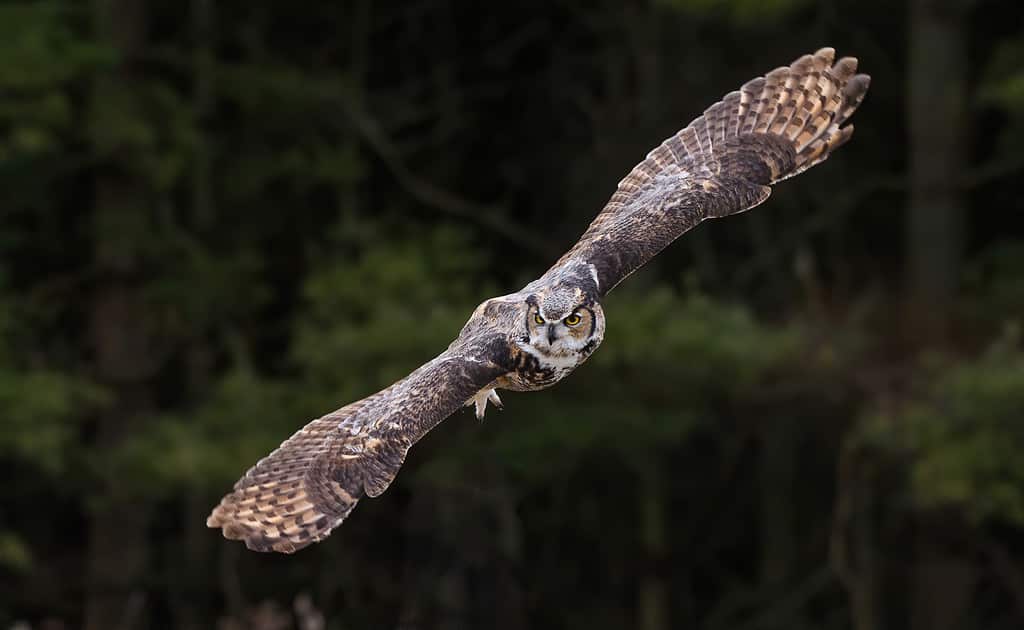
Great Horned Owls are one of the most well-known species of owl.
©yongsheng chen/Shutterstock.com
Starting off the list is the magnificent Great Horned Owl (Bubo virginianus). This iconic species has a very wide distribution and exists in most of the United States, as well as most parts of Canada.
Great Horned Owls have a distinctive appearance. They are easily identified by the prominent tufts that protrude vertically from the top of its skull. This is the feature that gives them their name.
The Great Horned Owl lives in California year-round. Great Horned Owls are quite large, although they aren’t the largest species of Owl in North America. That distinction belongs to the Snowy Owl. However, a full-grown adult Great Horned Owl can reach up to 24 inches in height and have a 57-inch wingspan.
California even hosts two different subspecies of this creature. These are the California Great Horned Owl and the Coastal Great Horned Owl. The first type lives in the deserts and flatlands of Southern California west of the Sierra Nevada. The latter lives along the west coast from Alaska to northern California.
2. Barn Owl

Barn Owls have a very distinctive heart-shaped face disk.
©Imogen Warren/Shutterstock.com
This is another very common species of owl that exists in every US state. In fact, it is one of the most widely distributed species of bird in the entire world, rivaled only by the pigeon. These owls exist from the heights of the Himalayas to the jungles of remote Polynesian islands.
Barn Owls (Tyto alba) can be easily identified by their distinctive pale coloration. They are also recognized by their heart-shaped faces that house two coal-black eyes. There is a very high amount of size variation with Barn Owls depending on subspecies and habitat. The average adult is about 14 inches in length with a 35-inch wingspan.
True to their name, Barn Owls like to roost in the scaffolding of barns and other buildings but also live in a variety of other cavities, such as holes in trees and fissures in the side of cliffs. These types of environments are where you can find this bird in California as well.
3. Burrowing Owl
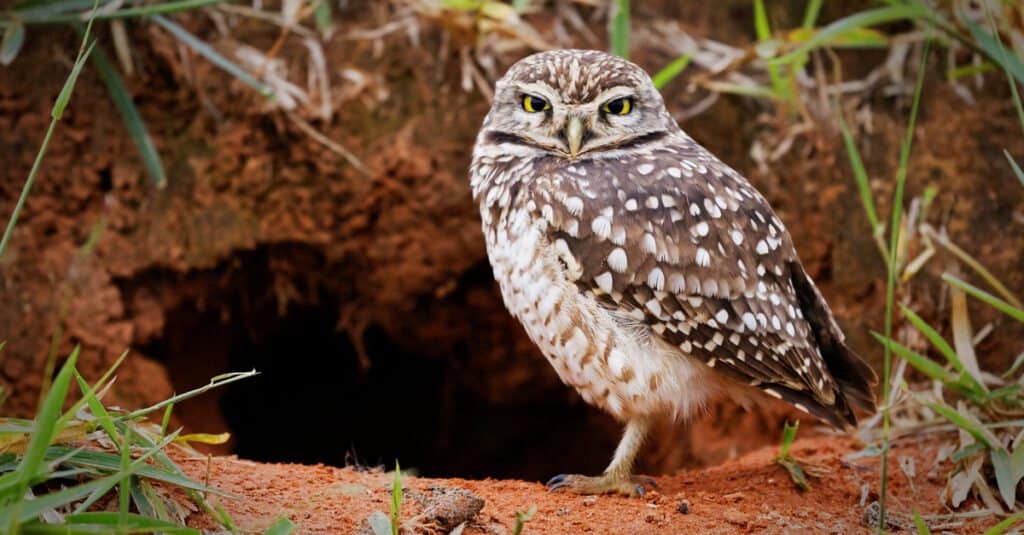
Burrowing Owls (
Athene cunicularia) make their nests in underground burrows.
©Mauricio S Ferreira/Shutterstock.com
These birds are another widely distributed species of owl. They can be found across the western United States in the summer and in most parts of California throughout the year. This owl also lives widely distributed throughout Central and South America. They are most commonly spotted in California in the winter.
True to its name, this bird likes to live in burrows and prefers to make its home in flat spaces like meadows and plains. An opportunist, it makes its nest in burrows that are created by groundhogs. This is a characteristic it shares with several other animals, such as rattlesnakes.
These owls depend on burrowing animals for their nesting sites, which is one reason the species is in slight decline. Prarie Dogs and other types of varmints are controlled and exterminated by farmers. This has led to population declines that have affected the population in North America.
4. Western Screech-Owl

Western Screech Owls (
Megascops kennicottii) have a distinctive vocalization.
©Steve Bruckmann/Shutterstock.com
These types of owls live throughout the western half of North America. The Screech owl is named for the high-pitched screech that makes up one of its calls. However, it also has another call that sounds like a series of short whistles.
Screech Owls live in California year-round and prefer to nest in the cavities of trees, banks, and cliffs. They do this on a very wide variety of surfaces and will shack up in anything from a cactus to an oak tree. They live in a wide variety of habitats in California as well, and a trip to nearly any environment can find you encountering one. Starting with a wooded, shady canyon might bring fruitful results.
5. Northern Pygmy-Owl

Northern Pygmy Owls (
Glaucidium californicum) have the strange habit of hunting by day.
©Jordan Feeg/Shutterstock.com
This is a petite species of owl that is also a relatively common sight across the American West. They can be found all across California, although they tend to avoid the heavily agricultural central valley of the state.
Pygmy-Owls nest primarily in dense wooded forests near streams. They also like to perch high atop tall conifers and the like. Their shrewd camouflage can make them difficult to spot without binoculars.
These owls are perennial residents of California, though the easiest time to spot one is between March and June. Unlike many species of owl, these owls like to hunt during the day.
6. Northern Saw-whet Owl
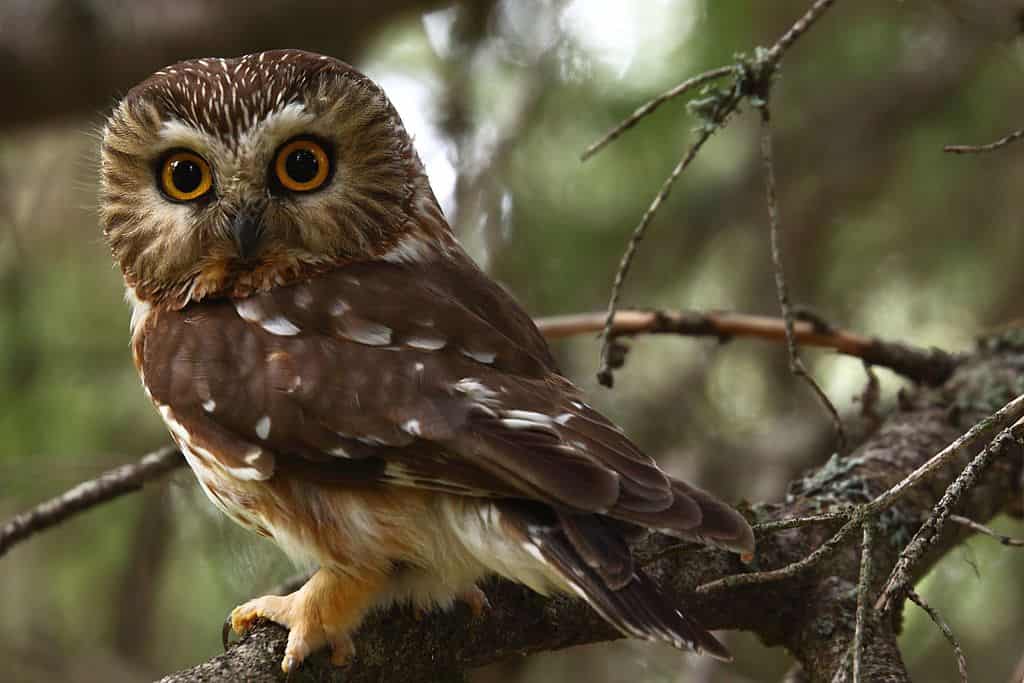
A male Northern Saw-Whet Owl with its distinctive orange eyes.
©Kameron Perensovich, CC BY-SA 2.0, via Wikimedia Commons – License
This entry holds the distinction of being the smallest species of owl in North America. This species of Owl typically only grows to be about seven inches in length. It likes to live in dense thickets and roosts low to the ground. This means that you can often catch this owl at eye level.
Northern Saw-Whet Owls (Aegolius acadicus) live throughout North America. In California, they prefer to stick either to the coast or to the east of the state on the border with Nevada. However, in the northern reaches of California, they live from east to west.
Northern Saw-whet Owls are very precise hunters who can hunt in the dead of night using only their hearing. This technique is sound localization. These owls will oftentimes prey on small mammals and birds and occasionally even seek out aquatic prey such as crayfish and frogs.
7. Short-eared Owl

Short-eared Owls (
Asio flammeus) are widespread across the globe.
©iStock.com/Harry Collins
These owls are identified by the small tufts on the top of their heads. These tufts aren’t ears per se but rather just distinctive-looking feathers. These owls are another species of owl that is very commonly distributed and can be found around the world. It tends to breed in the upper reaches of the Northern Hemisphere in boreal climates.
In California, this owl resides in the totality of the state but only breeds in the very upper reaches of the state. Because of its wide distribution, it is quite possible to see this owl in many different environments in the state. These range from desert chaparral woodlands to moist temperate forests.
These birds often hunt at night but will also hunt in the evening and twilight. Its preferred food is voles, but it will also pursue many other small mammals and birds.
8. Long-eared Owl
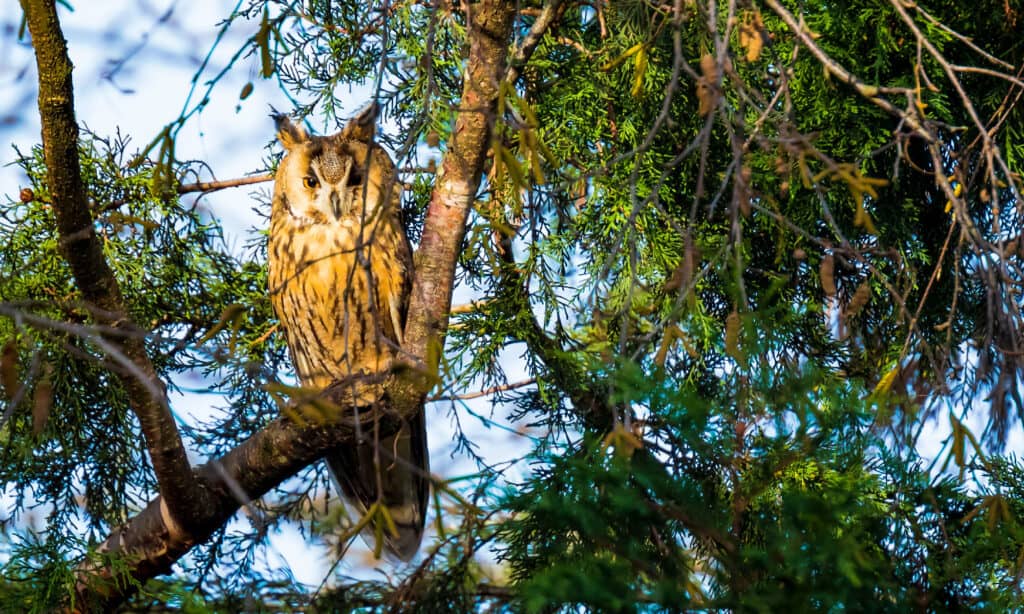
Long-eared Owls have distinctive tufts of feathers that protrude from their heads.
©SanderMeertinsPhotography/Shutterstock.com
The Long-eared Owl (Asio otus) is oftentimes confused with the preceding entry on this list, the Short-eared Owl. Adding to the confusion is the fact that these two owls oftentimes share habitats and colorations. Luckily, their distinctive head feather tufts are quite a bit longer than the Short-ear Owl’s. This makes it an easy identification for onlookers with a keen eye.
Long-eared Owls don’t have quite the distribution of their Short-eared cousins but are still quite common and live globally. In California, they live primarily in the southern end of the state along the coast, drifting down towards Baja California.
These owls like to nest and roost in environments that combine elements of grasslands and woods. A prairie with a nearby grove of pine trees would be an example of such a habitat. That being said, this highly adaptive animal can mold itself to thrive in a wide variety of ecosystems.
9. California Spotted Owl

A spotted owl with its distinctive plumage.
©C.M.Corcoran/Shutterstock.com
California Spotted Owls (Strix occidentalis caurina) are a charismatic species of owl named for the distinctive spotting patterns on the owl’s coat.
The Spotted Owl’s population and range is slightly less contiguous than many of the other owls on this list. In California, these owls live along the coast up until Marin County, just north of the Bay Area. There’s a break in their range, which resumes in Monterey County, where they exist all the way down into Baja California.
Spotted Owls like to roost and nest in a wide range of hardwood and coniferous forests. This includes dryer environments in their southern range. Interestingly, this species responds well to forest fires and will establish itself quickly in burn areas. High fire activity also seems to increase its reproduction rate.
10. Flammulated Owl
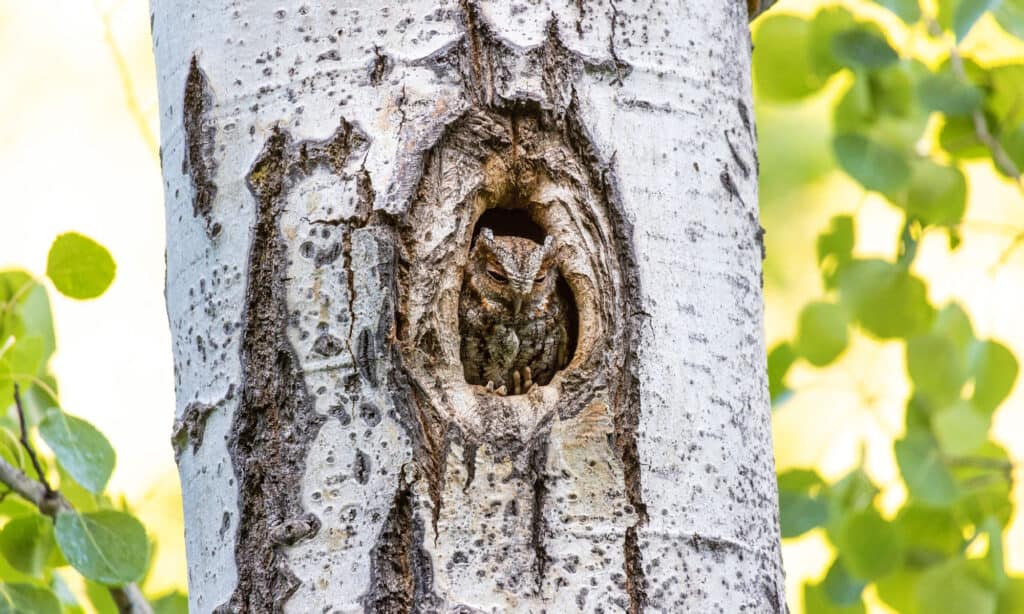
Flammulated owls often roost in concave hollows.
©iStock.com/Devonyu
The Flammulated Owl (Psiloscops flammeolus) is a small species of owl that dwells in Northern California. This includes the Klamath and northern Sierra Nevada mountain ranges. Flammulated Owls breed in California from April to October.
Flammulated owls are another species of owl that likes to nest in tree cavities. Some preferred species for these owls include Ponderosa Pine and Douglas Fir Forests. However, these owls will also nest and live in deciduous forest environments.
Flammulated Owls prefer to dine on small insects, a dietary habit that is somewhat uncommon among owls. They have a diverse set of calls and, like many owls, make their home in hollows and depressions. These owls are monogamous and tend to pair bond for several seasons in a row.
11. Great Gray Owl

Great Gray Owls (
Strix nebulosa) are one of the largest species of owl.
©Lynn_Bystrom/iStock via Getty Images
These creatures are relatively rare in California but are residents of the state year-round and exist in many of the state’s environments. These owls often live high in the northern hemisphere, in Russia, Canada, and Alaska. However, there is an isolated population that lives in Yosemite National Park. This is the last sanctuary of this species of owl in California.
These owls are one of the largest species of owl in the world, believed by some scientists to be the actual largest in terms of length. This owl prefers to live in dense conifer forests and taiga. Because of this, their populations face threats from the logging industries and other sources of deforestation.
These large owls have an enormous facial disk, the largest in the bird kingdom. This, paired with their distinctive grey feather coloration, yellow eyes, and massive size, makes them hard to mistake for anything else.
12. Snowy Owl
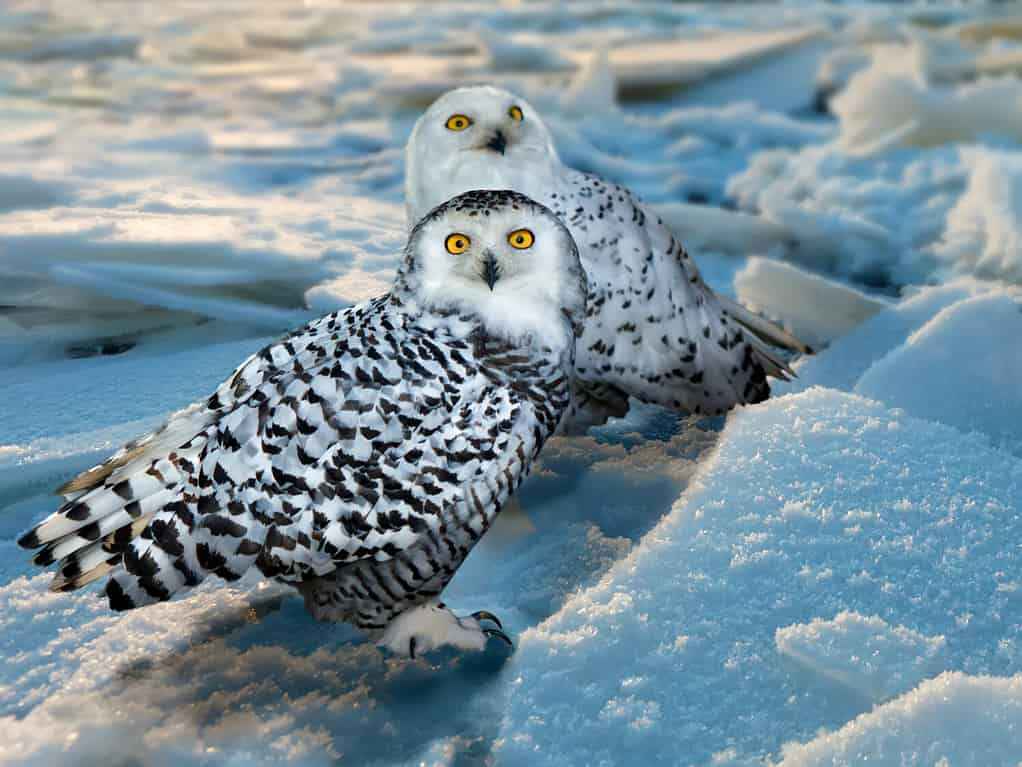
Snowy Owls rarely appear in California.
©BearFotos/Shutterstock.com
This member of the list is something more like an honorable mention, as the Snowy Owl (Bubo scandiacus) very rarely makes its way down from the northern climes to sunny California. However, in January 2023, a Snowy Owl made a visit to the Southern California suburb of Cypress. Snowy Owls are unmistakable in their bright white plumage that camouflage them perfectly with their arctic environment.
Snowy Owls are typically Arctic creatures who aren’t adapted to living in hot environments like many other owls. However, like many other species of owl, they are highly adaptable and migratory. This means that they can pop up in places where you least expect them. Another Snowy Owl was spotted a few years ago in Central Park, also very far away from its typical range.
13. Elf Owl

Elf Owls feign death in order to escape dangerous situations.
©Ed Schneider/Shutterstock.com
These birds are a relatively rare find in California, being much more common in Mexico and the other Southwestern states of the American West. In California, they live in the Southeastern corner of the state in the Mojave Desert.
Elf Owls (Micrathene whitneyi) are the world’s lightest owls and one of the smallest in terms of length and wingspan. They like to live and breed in desert chaparral environments. The owls are crepuscular and are most active at dawn and dusk.
One interesting behavior of these owls is that they feign death as a survival strategy. This causes their would-be predators to loosen their grip, which allows the owls to flee. These owls follow a very diverse diet, chowing on many different species of insects, small mammals, and lizards. You can also occasionally find them dining on venomous prey such as scorpions and tarantulas.
14. Northern Spotted Owl
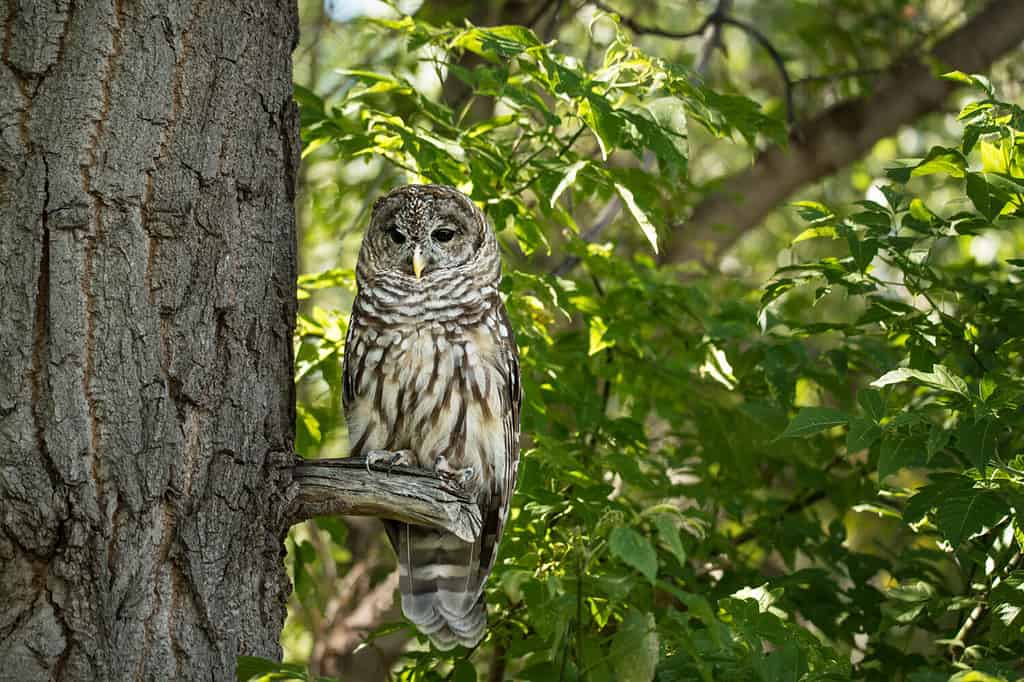
Northern Spotted Owls are endangered.
©Georgia Evans/Shutterstock.com
The Northern Spotted Owl (Strix occidentalis) is another subspecies of Owl. This owl follows many of the same behavioral patterns as the California Spotted Owl. As its name suggests, This subspecies of owl lives more frequently in the northern edges of California.
Northern Spotted Owls can be differentiated from other subspecies of Spotted Owls by their behavior in response to habitat disturbances. Unlike other variations of Spotted Owls, these owls are highly intolerant of any type of habitat disturbance. This feature has contributed to their endangered status: as of 2023, there are only 560 breeding pairs of this type of owl left in California.
15. Barred Owl

Barred Owls are somewhat invasive in the western half of the United States.
©Alannyiri/ CC BY-SA 3.0 – License
These birds are another Northern California resident living along the state’s northern coast beyond the Bay Area. They also live in the eastern portion of the state along the border with Nevada. These owls are much more common in the eastern half of the United States. For this reason, the owl is an invasive species in the American West.
Barred Owls (Strix varia) are a mid-sized owl that was once thought to be a subspecies of Spotted Owl. However, DNA testing has revealed these owls to be a distinct species. This species of owl has a beautiful and distinctive call, which is often described as “spectacular.” Purely nocturnal, these owls are most active between dusk and dawn.
These birds are adaptable predators that live in many different types of forests. You can find them in deciduous, mixed, and coniferous forests.
Summary: 15 Owls That Live in California
| Number | Name |
|---|---|
| 1 | Great-Horned Owl |
| 2 | Barn Owl |
| 3 | Burrowing Owl |
| 4 | Western Screech Owl |
| 5 | Northern Pygmy-Owl |
| 6 | Northern Saw-whet Owl |
| 7 | Short-eared Owl |
| 8 | Long-eared Owl |
| 9 | California Spotted Owl |
| 10 | Flammulated Owl |
| 11 | Great Gray Owl |
| 12 | Snowy Owl |
| 13 | Elf Owl |
| 14 | Northern Spotted Owl |
| 15 | Barred Owl |
The photo featured at the top of this post is © cindylindowphotography/Shutterstock.com
Thank you for reading! Have some feedback for us? Contact the AZ Animals editorial team.






